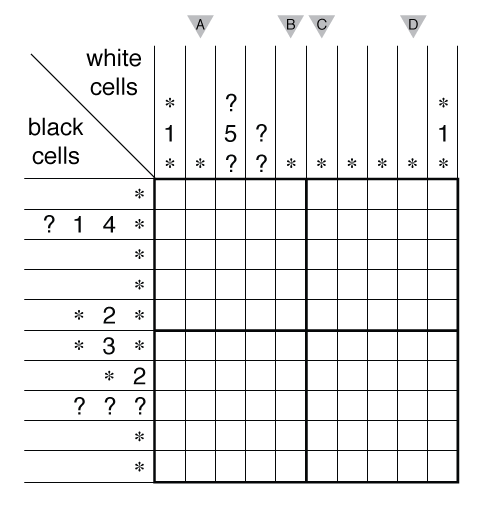Cross the Streams (Black and White + Partially Inverted) by Grant Fikes

or solve online (using our beta test of Penpa-Edit tools)
Theme: Logical
Author/Opus: This is the 119th puzzle from our contributing puzzlemaster Grant Fikes.
Rules: Double variations of Cross the Streams rules. First, both the shaded and the unshaded cells must be valid streams (single connected groups with no 2×2 areas). Second, while row clues act as usual and refer to shaded cells, the column clues refer to the distribution of white cells.
Answer String: Enter the length in cells of each of the black segments from left to right for the marked rows and from top to bottom for the marked columns in the two grids, going in order from A to B to C to D and separating each entry with a comma.
Time Standards (highlight to view): Grandmaster = 5:00, Master = 11:00, Expert = 22:00.
Solution: PDF; a solution video is available here.
Note: Follow this link for variations of Cross the Streams and this link for other classic Cross the Streams. If you are new to this puzzle type, here are our easiest Cross the Streams to get started on.

As much a “Yin Yang” variant as a “Cross the Streams” variant, and the usual Yin Yang gimmicks definitely provide most of the logic (including edge effects and the “no checkerboards” rule). Nice idea for a hybrid.
I’d never seen a “Yin/Yang” puzzle before, so this was a bit of an exercise in deriving the solving techniques you mention from scratch. Quite enjoyable once I got my head around the global logic needed to get started and got into the swing of it.
Second puzzle this week from Grant (CtS/LITS was the other) that required two attempts on my part (mainly since I solve with ink-on-paper rather than pencil or computer) to get an answer. The second attempt came very fast (since I had already figured out the rules Jack stated during my first failure).
Very nice puzzles from Grant as usual.
Ditto Francis. Good opportunity for minimal givens. My first ink attempt failed and my second one also.
Could this be considered a path puzzle or a region division puzzle because of the constraints on the path between the black and the white? For instance, the path length is empirically forced without knowledge of any givens. (What is it?)
05:44.
Great variant, crossing (no pun intended) Cross the Streams and Yin Yang. Of course I’m just going to reiterate what other people say, so I’ll stop here.
@John B: This is probably a region division, but certainly not path (as the two are not paths, simply walls like Nurikabe or Tapa that can branch). I think you broke the attempts because you consider this as a path puzzle?
I think it’s fair to consider that the boundary between the two regions is a path that enters and leaves the edges of the puzzle, and doesn’t touch or cross itself. It’s not an approach I’d use, but I doubt it would break anything. It does make the rules I mentioned above clear, for example.
I’ve seen different people use Pick’s Theorem applied to the path (the boundary between black and white) to derive some interesting facts about these puzzles, although I wouldn’t use the path while solving.
Pick’s Theorem has some interesting consequences in Yin Yang, yes.
All this talk about the path separating the black from the white is reminding me of when Everett Kaser was beta-testing Knarly Combs (a Yin Yang variant where the white cells are minesweeper clues), and commented that certain border configurations were hard for his computer program to fill. I swiftly provided a proof that, in an odd-sized Yin Yang grid, either the entire border is a single color, or the number of edge cells (excluding corners) of each color is odd. Probably helped him out a little. 🙂
I couldn’t work out the last third of the puzzle logically. I completed it by guesswork.
This one took me much longer than it really should have. Once I recognized that it is a Yin Yang, the solving went a lot more quickly.
Thanks for this enjoyable puzzle!
How do I begin this/ where can I find some yin yang puzzles everyone is talking about for some practice? Is there a walk through?
The strategies discussed above boil down to two main points:
1) Edge effects: In a Yin-Yang puzzle, the circles along the border must be arranged so that all the white circles form a continuous string, and all the black circles form a continuous string.
This means you can’t have patterns like “BWBW” along the border. If you did, it would be impossible to connect the black and white circles into two contiguous groups.
Try thinking about this rule in relation to Column 1 and Column 10. How would the 1’s have to be arranged in those columns in order to allow the white and black cells to both be connected?
2) No “checkerboard” pattern: This is similar to Cave puzzles, where you can have a pattern of “outside-inside, inside-outside” squares. In Yin-Yang puzzles, two configurations are impossible:
BW WB
WB BW
This is because Yin-Yang puzzles require all the white circles and all the black circles to be connected orthogonally. If the circles were in a checkboard pattern like above, it is impossible to connect the black circles without blocking off some of the white circles, and vice-versa.